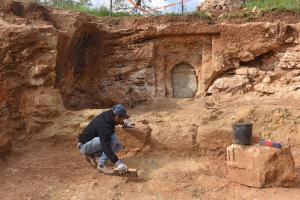March 27 (UPI) — Archaeologists have uncovered the remains of ancient agricultural village in east Jerusalem, including an extravagant burial estate, olive press and ritual baths.
The archeological evidence was dated to between 140 BC and 37 BC, situating the ancient village within the Hasmonean period. It was during the Hasmonean dynasty that Jerusalem assumed its geopolitical primacy.
During their excavation of the village, archeologists with the Israel Antiquities Authority uncovered many jar fragments, as well as a water cistern and rock quarries. The remains of the village were found beneath Jerusalem’s Sharafat neighborhood.
Researchers had previously uncovered evidence of baths and ancient living quarters at the site, but the discovery of a multi-generational burial chamber — the most significant discovery, so far — suggests the village was more expansive than archeologists realized.
The burial chamber was reached via a corridor that led to a courtyard with rock carvings, a stone bench and an entrance to the multi-chamber burial cave. Some of the decorative stone elements feature the kind of craftsmanship typically only found on monumental buildings or the burial estates of wealthy families.
“It seems that this burial estate served a wealthy or prominent family during the Hasmonean period,” Ya’akov Billig, head of the excavations and archaeologist with the Israel Antiquities Authority, said in a news release. “The estate was in use for a few generations as was common in that era.”
The latest discoveries suggest archaeologists have only uncovered a small portion of the ancient village. Researchers estimate much more remains underground. The evidence suggests the village was agricultural in nature. The village’s inhabitants likely produced wine and olive oil, among other products.
The excavations also revealed a dovecote carved into a stone wall. Dovecotes were pigeon nesting sites. During the Second Temple Period, between 516 BC and 70 AD, pigeons were bred for offerings at the temple, as well as for food. Their droppings would have been used as fertilizer.
Officials with the Israel Antiquities Authority are currently considering whether some of the excavated artifacts will be placed in a public exhibit.

COMMENTS
Please let us know if you're having issues with commenting.